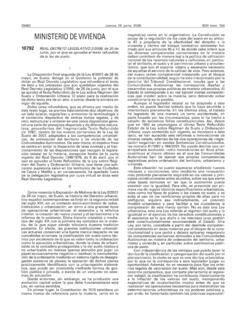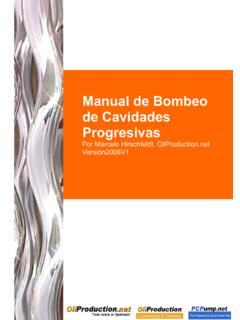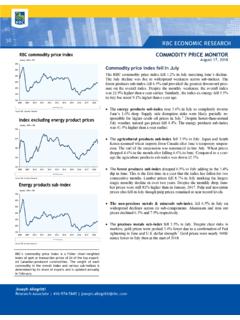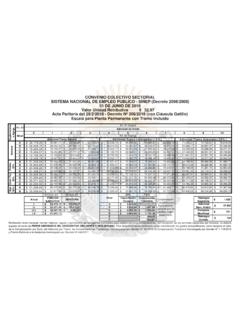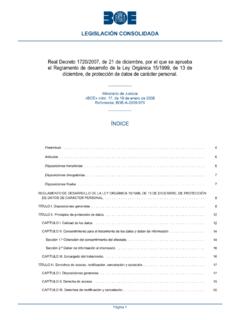Transcription of Infectious diseases of potential risk for travellers - …
1 53 CHAPTER 5. Infectious diseases OF potential RISK FOR TRAVELLERSD epending on the travel destination, travellers may be exposed to a number of Infectious diseases ; exposure depends on the presence of Infectious agents in the area to be visited. The risk of becoming infected will vary according to the purpose of the trip and the itinerary within the area, the standards of accommodation, hygiene and sanitation, as well as the behaviour of the traveller . In some instances, disease can be prevented by vaccination, but there are some Infectious diseases , including some of the most important and most dangerous, for which no vaccines precautions can greatly reduce the risk of exposure to Infectious agents and should always be taken for visits to any destination where there is a signifi cant risk of exposure. These precautions should be taken regardless of whether any vaccinations or medication have been of transmission and general precautionsThe modes of transmission for different Infectious diseases and the corresponding general precautions are outlined in the following and waterborne diseasesFoodborne and waterborne diseases are transmitted by consumption of conta-minated food and drink.
2 The risk of infection is reduced by taking hygienic precautions with all food, drink and drinking-water consumed when travelling and by avoiding direct contact with polluted recreational waters (see Chapter 3). Examples of diseases acquired by food and water consumption are traveller s diarrhoea, hepatitis A, typhoid fever and diseasesA number of particularly serious infections are transmitted by insects and other vectors such as mosquitoes and ticks. The risk of infection can be reduced by taking precautions to avoid insect bites and contact with other vectors in places where infection is likely to be present (see Chapter 3). Examples of vector-borne CHAPTER 5 Infectious diseases of potential risk for travellersINTERNATIONAL TRAVEL AND HEALTH 200954diseases are malaria, yellow fever, dengue, Japanese encephalitis, chikungunya and tick-borne encephalitis. Zoonoses ( diseases transmitted by animals)Zoonoses include many infections that can be transmitted to humans through animal bites or contact with animals, contaminated body fl uids or faeces, or by consumption of foods of animal origin, particularly meat and milk products.
3 The risk of infection can be reduced by avoiding close contact with any animals in-cluding wild, captive and domestic animals in places where infection is likely to be present. Particular care should be taken to prevent children from approaching or touching animals. Examples of zoonoses are rabies, tularemia, brucellosis, leptospirosis and certain viral haemorrhagic transmitted diseasesSexually transmitted diseases are passed from person to person through unsafe sexual practices. The risk of infection can be reduced by avoiding casual and unprotected sexual intercourse, and by use of condoms. Examples of sexually transmitted diseases are hepatitis B, HIV/AIDS and diseasesBloodborne diseases are transmitted by direct contact with infected blood or other body fl uids. The risk of infection can be reduced by avoiding direct contact with blood and body fl uids, by avoiding the use of potentially contaminated needles and syringes for injection or any other medical or cosmetic procedure that pene-trates the skin (including acupuncture, piercing and tattooing), and by avoiding transfusion of unsafe blood (see Chapter 8).
4 Examples of bloodborne diseases are hepatitis B and C, HIV/AIDS and diseasesAirborne transmission occurs when droplet nuclei (evaporated droplets) < 5 micron in size are disseminated in the air. These droplet nuclei can remain suspended in the air for some time. Droplet nuclei are the residuals of droplets and when suspended in the air, they dry and produce particles ranging in size from 1 5 microns. diseases spread by this mode include open/active pulmonary tuberculosis (TB), measles, chicken pox, pulmonary plague and haemorrhagic fever with pneumonia. 55 CHAPTER 5. Infectious diseases OF potential RISK FOR TRAVELLERSD roplet transmission occurs when there is adequate contact between the mucous membranes of the nose and mouth or conjunctivae of a susceptible person and large particle droplets (> 5 microns). Droplets are usually generated by the infected person during coughing, sneezing, talking or when health care workers undertake procedures such as tracheal suctioning.
5 diseases transmitted by this route include pneumonias, pertussis, diphtheria, SARS, mumps and transmitted from soilSoil-transmitted diseases include those caused by dormant forms (spores) of Infectious agents, which can cause infection by contact with broken skin (mi-nor cuts, scratches, etc). The risk of infection can be reduced by protecting the skin from direct contact with soil in places where soil-transmitted infections are likely to be present. Examples of bacterial diseases transmitted from soil are anthrax and tetanus. Certain intestinal parasitic infections, such as ascariasis and trichuriasis, are transmitted via soil and infection may result from consumption of soil-contaminated vegetables. Fungal infections may be acquired by inhalation of contaminated c Infectious diseases involving potential health risks for travellersThe main Infectious diseases to which travellers may be exposed, and precautions for each, are detailed on the following pages.
6 Information on malaria, one of the most important Infectious disease threats for travellers , is provided in Chapter 7. The Infectious diseases described in this chapter have been selected on the basis of the following criteria: diseases that have a suffi ciently high global or regional prevalence to consti-tute a signifi cant risk for travellers ; diseases that are severe and life-threatening, even though the risk of exposure may be low for most travellers ; diseases for which the perceived risk may be much greater than the real risk, and which may therefore cause anxiety to travellers ; diseases that involve a public health risk due to transmission of infection to others by the infected about available vaccines and indications for their use by travellers is provided in Chapter 6. Advice concerning the diseases for which vaccination is routinely administered in childhood, diphtheria, measles, mumps and rubella, pertussis, poliomyelitis and tetanus, and the use of the corresponding vaccines later INTERNATIONAL TRAVEL AND HEALTH 200956in life and for travel, is also given in Chapter 6.
7 These diseases are not included in this most common Infectious illness to affect travellers , namely travellers diar-rhoea, is covered in Chapter 3. Because travellers diarrhoea can be caused by many different foodborne and waterborne Infectious agents, for which treatment and precautions are essentially the same, the illness is not included with the specifi c Infectious of the diseases included in this chapter, such as brucellosis, HIV/AIDS, leishmaniasis and tuberculosis, have prolonged and variable incubation periods. Clinical manifestations of these diseases may appear long after the return from travel, so that the link with the travel destination where the infection was acquired may not be readily INFLUENZAC ause Highly pathogenic avian influenza A(H5N1) virus, or other non-human influenza subtypes ( , H9). Transmission Human infections with highly pathogenic avian influenza A(H5N1) virus occur through bird-to-human, possibly environment-to-human, and very rarely limited, non-sustained human-to-human transmission.
8 Direct contact with infected poultry, or surfaces and objects contaminated by their droppings, is the main route of transmission to humans. Exposure risk is considered highest during slaughter, de-feathering, butchering, and preparation of poultry for cooking. There is no evidence that properly cooked poultry or poultry products can be a source of of disease Patients usually present initially with symptoms of fever and influenza-like illness (malaise, myalgia, cough, sore throat). Diarrhoea and other gas-trointestinal symptoms may occur. The disease progresses within days and almost all patients develop clinically apparent pneumonia with radiographic infiltrates of varying patterns. Sputum production is variable and someti-mes bloody. Multi-organ failure, sepsis-like syndromes, and uncommonly encephalopathy, occur. The fatality rate among hospitalized patients with confirmed H5N1 infection has been high (about 60%), most commonly as a result of respiratory failure caused by progressive pneumonia and acute respiratory distress distribution Extensive outbreaks in poultry have occurred in parts of Asia, the Middle East, Europe and Africa since 2003, but only sporadic human infections have occurred to date.
9 Continued exposure of humans to avian H5N1 viruses increases the likelihood that the virus will acquire the necessary characteris-tics for efficient and sustained human-to-human transmission through either gradual genetic mutation or reassortment with a human influenza A virus. Between November 2003 and July 2008, nearly 400 human cases of labo-ratory-confirmed H5N1 infection were reported to WHO from 15 countries in South-East and central Asia, Europe, Africa and the Middle 5. Infectious diseases OF potential RISK FOR TRAVELLERSRisk for travellers H5N1 avian influenza is primarily a disease in birds. The virus does not easily cross the species barrier to infect humans. To date, no traveller has been infected. The risk of infection is increased by prolonged, close and heavy exposure to the Neuraminidase inhibitors (oseltamivir, zanamivir) are inhibitory for the virus and demonstrate proven efficacy in vitro and in animal studies for prophylaxis and treatment of H5N1 infection.
10 Studies in hospitalized H5N1 patients, although limited, suggest that early oseltamivir treatment with oseltamivir improves survival and given the prolonged virus replication, late intervention with oseltamivir is also justified. Neuraminidase inhibitors are recommended for post-exposure prophylaxis in certain exposed persons. At present WHO does not recommend pre-exposure prophylaxis for travellers but advice may change depending on new findings. Inactivated H5N1 vaccines for human use have been developed and licensed in several countries but are not yet generally available although this situation is expected to change. Some countries are stockpiling these vaccines as a part of pandemic preparedness. Although immunogenic, the effectiveness of these vaccines in preventing the H5N1 infection or reducing disease severity is unknown. Currently, WHO does not have a policy in its use. Precautions travellers should avoid contact with high-risk environments in affected countries such as live animal markets and poultry farms, any free-ranging or caged poultry, or surfaces that might be contaminated by poultry droppings.










